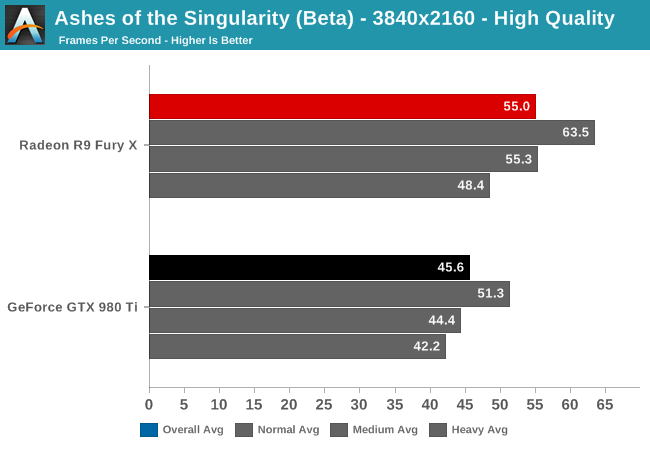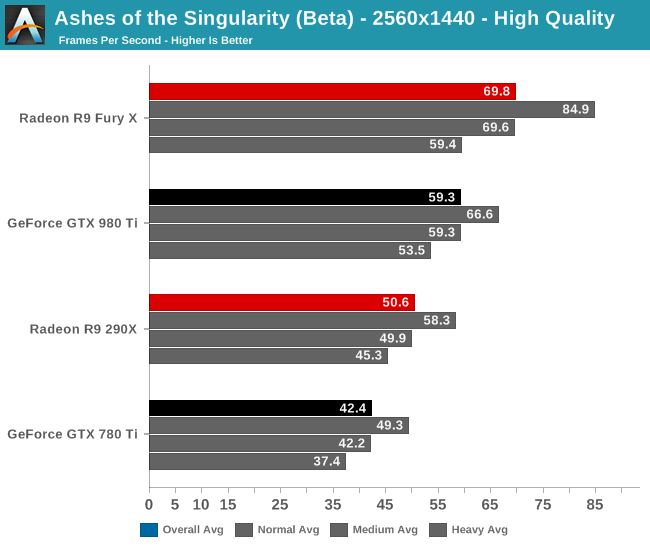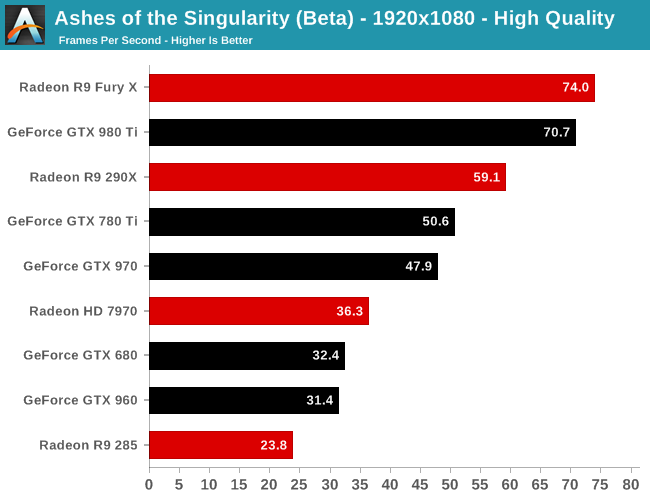Ashes of the Singularity Revisited: A Beta Look at DirectX 12 & Asynchronous Shading
by Daniel Williams & Ryan Smith on February 24, 2016 1:00 PM ESTDirectX 12 Single-GPU Performance
We’ll start things off with a look at single-GPU performance. For this, we’ve grabbed a collection of RTG and NVIDIA GPUs covering the entire DX12 generation, from GCN 1.0 and Kepler to GCN 1.2 and Maxwell. This will give us a good idea of how the game performs both across a wide span of GPU performance levels, and how (if at all) the various GPU generational changes play a role.
Meanwhile unless otherwise noted, we’re using Ashes’ High quality setting, which turns up a number of graphical features and also utilizes 2x MSAA. It’s also worth mentioning that while Ashes does allow async shading to be turned off and on, this option is on by default unless turned off in the game’s INI file.

Starting at 4K, we have the GeForce GTX 980 Ti and Radeon R9 Fury X. On the latest beta the Fury X has a strong lead over the normally faster GTX 980 Ti, beating it by 20% and coming close to hitting 60fps.

When we drop down to 1440p and introduce last-generation’s flagship video cards, the GeForce GTX 780 Ti and Radeon R9 290X, the story is much the same. The Fury X continues to hold a 10fps lead over the GTX 980 Ti, giving it an 18% lead. Similarly, the R9 290X has an 8fps lead over the 780 Ti, translating into a 19% performance lead. This is a significant turnabout from where we normally see these cards, as 780 Ti traditionally holds a lead over the 290X.
Meanwhile looking at the average framerates with different batch count intensities, there admittedly isn’t much remarkable here. All cards take roughly the same performance hit with increasingly larger batch counts.

Finally at 1080p, with our full lineup of cards we can see that RTG’s lead in this latest beta is nearly absolute. The 2012 flagship battle between the 7970 and the GTX 680 puts the 7970 in the lead by 12%, or just shy of 4fps. Elsewhere the GTX 980 Ti does close on the Fury X, but RTG’s current-gen flagship remains in the lead.
The one outlier here is the Radeon R9 285, which is the only 2GB RTG card in our collection. At this point we suspect it’s VRAM limited, but it would require further investigation.










153 Comments
View All Comments
dustwalker13 - Thursday, February 25, 2016 - link
or ... not to put to fine a point on it, nvidias program and strategy to optimize games for their cards (aka in some instances actively sabotaging the competitions performance through using specialized operations that run great on nvidias hardware but very poorly on others) has lead to a near perfect usage of DX11 for them while amd was struggling along.on ashes, where there is no such interference, amd seems to be able to utilize the strong points of its architecture (it seems to be better suited for DX12) while nvidia has had no chance to "optimize" the competition out of the top spot ... too bad spaceships do not have hair ... ;P
prtskg - Thursday, February 25, 2016 - link
Lol! spaceships don't have hair. I'd have upvoted your comment if there was such an option.HalloweenJack - Thursday, February 25, 2016 - link
Waiting for Nvidia to `fix` async - just as they promised DX12 drivers for Fermi 4 months ago.....Harry Lloyd - Thursday, February 25, 2016 - link
Well, AMD has had bad DX11 performance for years, they clearly focused their architecture on Mantle/DX12, because they knew they would be producing GPUs for consoles. That will finally pay off this year.NVIDIA focused on DX11, having a big advantage for four years, and now they have to catch up, if not with Pascal, then with Volta next year.
doggface - Thursday, February 25, 2016 - link
Personally as the owner of an nVidia card, I have to say Bravo AMD. That's some impressive gains and I look forward to the coming D12 GPU wars from which we will all benefit.minijedimaster - Thursday, February 25, 2016 - link
Exactly. Also as a current Nvidia card owner, I don't feel the need to rush to a Windows 10 upgrade. Seems I have several months or more before I'll be looking into it. In the mean time DX11 will do just fine for me.mayankleoboy1 - Thursday, February 25, 2016 - link
AMD released 16.2 Crimson Edition drivers with more performance for AotS.Will you be re-benchmarking the game?
Link: http://support.amd.com/en-us/kb-articles/Pages/AMD...
albert89 - Thursday, February 25, 2016 - link
The reason why Nvidia is losing ground to AMD is because their GPU's are predominantly serial or DX11 while AMD as it is turning out is parallel (DX12) and has been for a number of years. And not only that, but are on their 3rd Gen of parallel architecture.watzupken - Thursday, February 25, 2016 - link
Not sure if its possible to retest this with a Tonga card with 4GB Vram, i.e. R9 380x or 380? Just a little curious why it seems to be lagging behind quite a fair bit.Anyway, its good to see the investment in DX 12 paying off for AMD. At least owners of older AMD cards can get a performance boost when DX 12 become more popular this year and the next. Not too sure about Nvidia cards, but they seem to be very focused on optimizing for DX 11 with their current gen cards and certainly seems to be doing the right thing for themselves since they are still doing very well.
silverblue - Friday, February 26, 2016 - link
Tonga has more ACEs than Tahiti, so this could be one of those circumstances, given more memory, of Tonga actually beating out the 7970/280X. However, according to AT's own article on the subject - http://www.anandtech.com/show/9124/amd-dives-deep-... - AMD admits the extra ACEs are likely overkill, though to be fair, I think with DX12 and VR, we're about to find out.